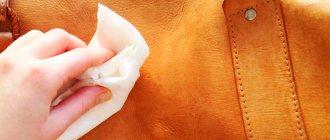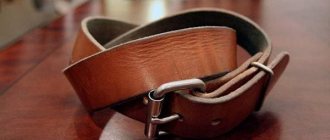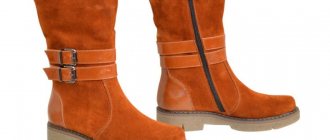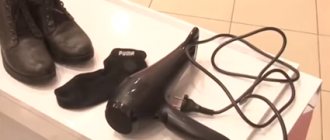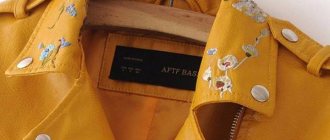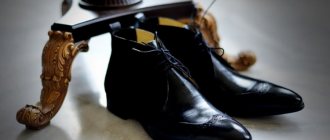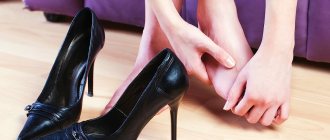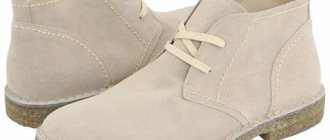Ways to soften shoes
Made from genuine leather
The supermarket sells many different products to soften hard skin. Well-known manufacturers produce creams and sprays for shoe care.
Before treatment, apply a spray to the damaged area. Then it is lubricated with cream. Factory products can be replaced with alcohol, but softening will take much longer.
To soften natural rough skin, do not treat it with sunflower oil. This will make her even tougher.
Shoes made of genuine leather lend themselves well to softening. You can use methods such as rubbing with Vaseline, vinegar solution, and kerosene.
You can try this method: cover the hard part of the shoe with a thick cloth and then tap with a hammer on the area that needs to be softened. Put on shoes and walk around in them; if the effect is not good enough, then repeat the procedure, but the main thing is not to overdo it.
PU Leather
The best way to soften such skin is to create a greenhouse for it. To do this, you need to moisten a cloth with water and wrap it around the box of shoes. Wait until the rag is completely dry.
You can use newspapers to soften:
- wet the crumpled newspaper;
- stuff your shoes tightly with it;
- leave for a while so that the newspaper dries well.
Heel counter
Sometimes shoes fit perfectly on the foot, but a hard heel prevents you from walking normally. The most common methods to soften it:
- Take a hammer and tap the shoe in and around the heel area. Carry out the procedure carefully so as not to damage the shoes. If the skin color is light or it is thin, then you need to tap through a dense material.
- Moisten the backs with vinegar. It will soften them well, but not everyone can tolerate its pungent smell.
- Purchase special softening products. However, this method will not save money.
- You can apply sunflower oil to the heel and leave it overnight if the shoes are made of artificial materials. During this time it should become softer.
- Sew or carefully glue a soft cloth to the back. It will protect the heel from friction with hard skin.
- Shoe departments sell special pads. They are glued on the inside to protect the heel from rubbing. But there is a drawback: with active walking, the pad can move out.
- Use special pencils. They will make the inside slippery, which will reduce friction.
- If none of the methods helped in the fight against a hard heel, then you should contact a workshop, perhaps they will find another solution.
Softening the skin inside
To soften the leather inside the shoe, you can use these tips.
- Moisten the inside of the shoes with alcohol, put them on and walk in them for about 2 hours. This will help soften stiff areas and also stretch small shoes.
- Rub the inside of the shoe with paraffin (a regular candle) and leave overnight. In the morning, remove excess product. The method will get rid of calluses.
- Stuff each shoe or shoe with wet newspapers. Allow to dry, but away from heating appliances.
- You can also try this unusual method. Pour water into the bags (¼ part), put them inside the shoes (boots), put the shoes in the freezer, let the water freeze, then take out the shoes and try them on.
Getting rid of hard heels
An ordinary paraffin candle or laundry soap will help soften the backdrops a little. Rub one of these products on the inside of the heel of your shoe and try walking. You can also soften the backdrop with vinegar, generously moistening the skin in the problem area.
Alcohol diluted with water in a 1:1 ratio will help make artificial shoe materials soft. Moisten the backdrop with it and “break” it with your hands. Before the procedure, make sure that there is no cardboard insert in the heels; if it gets wet, it will get wet and the shoes will lose their shape.
Softening the back of boots with a hammer - video
If your favorite shoes or new sneakers rub your skin, don’t worry. You can soften them at home. When choosing softening products, pay attention to the material from which the shoes are made. Choose the method that suits you and enjoy walking in your favorite shoes or sneakers!
Castor oil. Moreover, only the “heads” of boots, which are made of genuine pigskin, can be softened. The tarpaulin boot does not soften or stretch at all.
The skin should be thickly lubricated with castor oil until it stops absorbing it. And then pull it onto the block and leave it warm, or on your foot and walk around in boots.
It should be noted that the top of tarpaulin boots (the tarpaulin material itself, which is a special leatherette) is still resistant to shoe polish and can only be cleaned with natural wax.
Leather shoes are the most common and comfortable to wear. But hard boots or shoes that are impossible to wear are a huge problem. It happens that you have to refuse new shoes just for this reason. However, you can try to soften the skin with improvised means.
How to soften shoes yourself: home remedies
The most proven method for wearing shoes, which was used by our grandmothers, is woolen socks. Soak them in alcohol or vodka, put on your shoes and walk around in them for as long as possible. Alcohol will have an aggressive effect on the surface of the shoe, and the sock will help it stretch faster.
This method is great for softening the seams of fabric sneakers. When stretching leather shoes, it is better not to use alcohol.
How to stretch natural and artificial leather
If the shoes made of genuine leather are very hard, place a soft cloth on the hard part and lightly tap the desired area with a hammer, then walk in the shoes. There is an effect - good, no - try again, but do not overdo it, so as not to spoil the product.
Faux leather shoes can also be softened a little by using newspapers.
- Wet the crumpled pieces of newspaper.
- Stuff your shoes tightly with them.
- Leave until completely dry.
Some sources suggest softening shoes with glycerin or sunflower oil. We do not recommend that you use these products. Although sunflower oil will soften the skin, over time it will become even rougher. Glycerin will also give a good effect at first, but then the leather on the shoes will begin to crack.
How to make leather shoes soft - video
Removing the stiffness of patent leather shoes and boots
How to “make” new, but not too soft patent leather shoes “love” your feet? Models with a varnished surface require delicate handling. One of the most effective ways to soften this material is any greasy cream and a hair dryer.
- Apply the cream to the inside of your shoes.
- Warm it up thoroughly from the inside.
- Wear thick socks.
- Put on shoes and walk for as long as possible.
Monitor the temperature while warming up; shoes that are too high may lose their shine.
Softening shoes with a hairdryer - video
How to break in suede and nubuck shoes
You can soften suede shoes using the same methods that are used for leather products:
- mechanical (hammering);
- hot (using a hairdryer);
- treatment with a skin softening spray purchased in a store.
Is it possible to return hard shoes to the store?
If you nevertheless purchased shoes or sneakers and after a walk you find that they are rubbing your feet, is it possible to return such shoes to the seller? Make no mistake, they will not be accepted back with such a claim. If no manufacturing defects are found on the shoes, which are revealed through examination, it is impossible to return them to the store after wearing them.
Factory defects in shoes can only be detected through a special examination.
Another case is also possible: you have not had time to wear the boots and the warranty period (14 days from the date of purchase) has not yet expired. The boots have not lost their consumer appearance, but you have already realized that they are made of rough leather and will rub your feet. Then try contacting the seller, present your unworn shoes, receipt, packaging, all labels and say that this product did not suit you in its shape, size, color, style, dimensions. There is a high probability that you will defend your rights and you will get your money back or be offered another product.
Softeners
There are many different products available to soften hard leather on shoes. The following can be distinguished:
- A shoe workshop where specialists stretch shoes on special lasts and beat off hard spots with various devices.
- Professional creams and sprays for shoe care. It is advisable to apply them immediately after purchasing shoes.
- Folk remedies. This is something that can be found in a home medicine cabinet or in the kitchen. Let's look at the most effective softening methods at home.
How to choose ankle boots so they don't chafe
Using these methods, you will be able to break apart the ankle boots. But this will take some time, during which you will have to endure inconvenience. Choosing the right shoes will help reduce discomfort .
- When purchasing, try on a thick wool sock.
- If you don’t have such a sock when trying on, choose those that are 1 size larger than you need.
- Give preference to trusted manufacturers who will ensure the quality of materials and products as a whole.
Now you know how to stretch ankle boots, making them not only practical, but also comfortable to use. And most importantly, you can protect your feet from wounds, abrasions and abrasions even with prolonged use of the products. All the methods that we talked about were tested in practice and really helped in working with ankle boots. We hope your shoes become comfortable too!
Survival equipment: Tarpaulin boots. Kind words.
So, here they are, fresh, in person:
The advantages of kirzachs are as follows: - they are universally suitable. Naturally, I understand that there are no completely suitable shoes (that is, ones that are great both in the desert and at the North Pole). In the same way, there are special wearing conditions (mountain climbing and mountaineering, parachute jumping, leaving a wet torpedo tube, duck hunting in a swamp) and special shoes corresponding to them.
But if we talk specifically about such an “average tourist,” then kirzachi can solve almost all of his “problems.” You can walk in the forest and in the field in them, climb a little in the mountains (not Everest, of course), walk on wet soil, you can wear them from spring to autumn, you can take them on a trip alone. More on this below. - they are cheap.
I don’t know how it is in other towns, but in Novosibirsk you can buy them (new!) at a cost from 800 (according to advertisements on Avito) to 1300 (“fishing and hunting store”) rubles. At the same time, “normal” hiking sneakers cost from 2,500 rubles and more (and that’s if you’re even lucky), while various “cool” boots of some sort will cost even more, about twice as expensive as sneakers. And it’s not a fact that the period of their usual wear will be longer.
- they are highly durable. The top is a strong fabric impregnated with something rubbery; bottom – leather. The sole is strong, thick, nailed with fifty nails. Here, as they say, there is nothing to break at one moment. With normal care, you can be sure that in the morning they will not get wet, the soles will not fall off, the seams or any seals will not become loose. Naturally, they will also fall apart evenly, but this will be expected and predictable, and, in the latter case, they can be repaired on the go with improvised means.
The absence of any valves, “smart fabrics”, “insoles with artificial intelligence” and “microcompressors on Black energy for purging the heel area and piquant massage of the toes” leads to the fact that all this will not break down and will not turn into a problem. Boots bathed in a swamp will remain boots. - as a result, these are “killing shoes.” Not in the sense that they want to kill. You can do in them what is “expensive” or “sorry” to do in other shoes. I’m not in any way advocating treating shoes like a beast (I take care of mine and take care of them), but I don’t see the point in turning a trip into global saving of expensive equipment (“God forbid I get a sneaker wet or scratch a patent leather shoe!”).
Therefore, in these boots you can walk on stones, overcome fords and huge puddles, wade through thorns or windfalls. Yes, there is a lot more that is possible. At least put out a coal that fell out of the fire without fear of melting the sole in a second. When cutting through thick bushes, nothing will get caught in them or tear. The laces will never break or come undone at the most inopportune moment (and you don’t need to think about whether to take a supply of these laces with you, and how many, and which ones, and where to store them...), these laces will not be “overgrown” with a bunch of clinging plant seeds threatening to prick your finger when tying. - passable water resistance. Like all multi-element shoes, they slowly leak along the joints and seams.
But with normal care this happens slowly and does not cause any particular inconvenience. Obviously, standing in the river for half a day in them is not at all comme il faut, but going through several fords or a wetland is completely acceptable. In them you can simply walk on damp grass, soaked in morning dew or drenched in rain (and in sneakers?). - your feet “breathe” in them. Due to the leather bottom, the feet do not sweat, and, as a result, do not force others to urgently find a gas mask at the end of a hot day, and do not freeze when it is cold (don’t forget about warm socks).
By tucking the boot down, you can further improve ventilation. Naturally, when it’s hot, they’re a little hot, but your feet don’t burn like in an oven, and the specific “tarpaulin” smell isn’t that terrible. In the same way, there are no diaper rashes, no inflammations, or other rubbish that some tourists tend to complain about. In cold weather, they are warmer due to the fact that a boot with a tucked-in trouser leg retains more air than boots or sneakers.
— Molded and worn-in boots are practically not felt on the foot, and it is even easier to wear leather “to suit yourself” than synthetics. For example, I enjoy wearing them during all the dacha-garage-camping periods of my life, almost every day (except for “civilian” life, of course), and I feel them almost like house slippers. - they are tall and protect the leg (from water, thorns, pebbles, dust and dirt, insects) almost to the knee. - they can be put on quickly and easily.
It doesn’t matter what you need (to go “into the bushes” on wet grass at night, or to urgently run away from a forest fire) - you can put on boots even without socks in a few seconds, and get to work. This is faster than lacing or fastening something, especially with sleepy or shaking hands. — possibility of tuning. It is important. If desired, you can experiment with insoles and socks (foot wraps), sew on any additional elements you like, and remake the sole tread. For example, on one of the versions of my own boots, I completely cut off the “standard” tread. The boots became even more slippery (as expected), but also even softer, somehow gentle, it was extremely easy to drive and walk in them (the feeling of that “oakiness” that was still there disappeared). But the most important thing is that you can fit the usual and necessary NAZ into your boots.
